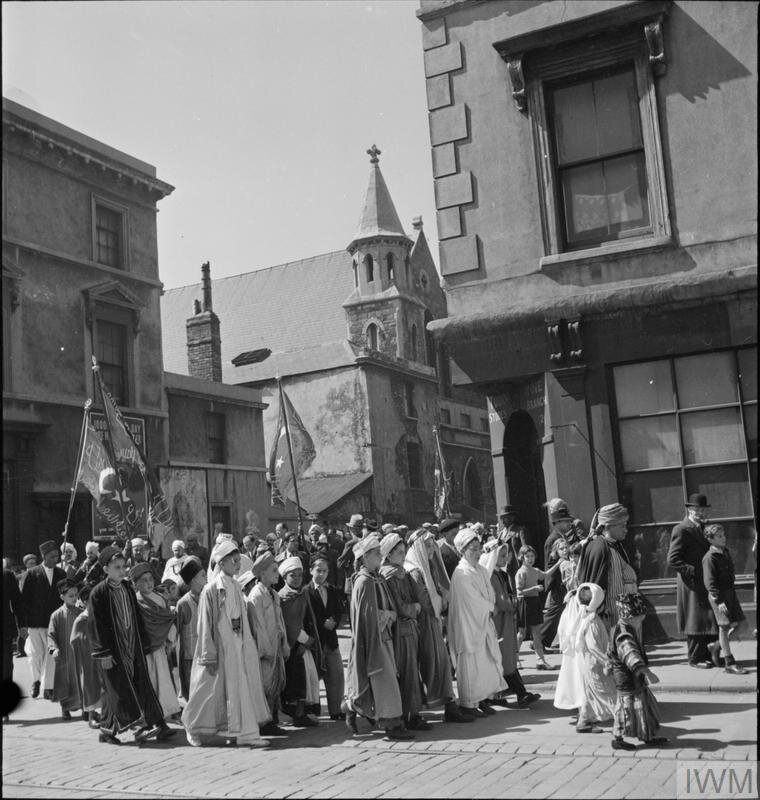Lobna Omar takes you back to 1930’s Britain to share the story of Cardiff’s multicultural community.
"We started talking and I think we fell in love then and there."
That’s how Olive described her first conversation with the Yemeni Chef Salman when she bumped into him at the Cairo Café.
Fifteen-year-old Olive didn’t imagine she would find love when she moved from the Rhondda Valley in South Wales to work as a nurse in Cardiff. But it just so happened that on that day, Salman, who was the manager of the Cairo Café, had headed out for little fresh air— there he found Olive, unbeknownst to him, the woman who would be his future wife. Olive had got slightly lost, so when she asked him the way back to Queen Street, their short conversation was to be the first spark in a lifelong relationship.
Salman and Olive’s biracial union wasn’t unheard of for Cardiff, especially in Tiger Bay, where interracial marriage was common as a result of increasing numbers of immigrants who had arrived in the city.
Dawoud, one of Olive's sons, says that the people of Tiger Bay “lived in a phenomenal integration, as it was a destination for immigrants seeking suitable life from more than fifty countries from the 1800s until World War II.”
Tiger Bay had become a hub for migrants due to the city’s prosperous coal trade. In 1904, the Coal Exchange witnessed the first £ 1 million cheque. "Cardiff was like Saudi Arabia at the turn of the 20th Century," says Neil M. C. Sinclair the author and historian.
As such Cardiff is now one of the most mixed British communities to this day.
Men gathered at the Coal Exchange building where the first million-pound cheque was signed.
An improved economy is always followed by enriched culture.
"Tiger Bay was described in 1911 as one of the most delightful and diverse places on earth, with Caribbean and soul music everywhere," says author Richard Cordle.
Slowly but surely, these cultural seeds grew in the fertile lands of Cardiff, creating a community that is certainly one of a kind.
After the British occupation of coal-rich Aden, the Capital of Yemen in 1839, Salman's family, like many others, from Yemen migrated to Tiger Bay. Which created a strong Yemeni community in Cardiff. Each wave of migration added something new to the bustling seaside city.
Wales would not have known curry if it were not for Mr. Ali's restaurant, and there would not have been a place of prayer for Muslims before the arrival of the Somali sailor who decided to build the Nur Al-Islam mosque.
Author Neil Sinclair described his favourite place in Tiger Bay.
“It doesn't matter what your skin colour is, your religion, or where you come from, in this place everybody lives in peace, and no one shuts the door in the face of the other."
In the mid-1930s, Tiger Bay became an international example of harmony and unity becoming a home to 30,000 sailors from all over the world. Such as the Middle East, Africa and the Caribbean.
Sinclair, a resident of Tiger Bay, describes in the BBC documentary ‘Mixed Britannia’ the streets of his childhood.
"All people of the neighbourhood from different backgrounds and ethnicities would gather at religious events such as the holidays and Ramadan," Sinclair said. "They used to walk the streets next to the Arabs in their traditional clothes distributing food to passers-by like chicken curry and rice especially at Eid. Although we are Christians, we used to go to Arabic school with our Arab and Muslim friends just for fun!"
As Arabs parade the city center, children watch with bright eyes
Children lead the parade of Arabs in the streets.
In 1939, the author Howard Spring visited the neighbourhood and described what he saw in these words.
"Shop windows were decorated with names that were an epitome of all the clans and classes under the sun," Spring said. "The flags of all nations fluttered on the housefronts.”
But now, back to the story of Salman and Olive. The couple married three weeks after the first day they met, despite facing challenges from the wider community due to their racial and religious differences. After their marriage, Olive and Salman worked in their cafe serving delicious dishes to the hungry and tired sailors who had worked long days at sea.
The Cairo Cafe, that the couple now ran was not just a cafe, but also a school and a mosque. In other words, it was a whole institution and a place where the citizens of the neighbourhood got together and spent time together.
Olive and Salman made their living serving food to hungry customers.
During a visit in the 1950s, The Welsh poet, writer and broadcaster Gwyn Thomas said: "Whenever any two children of different races play together, humanity grows an inch or two; another ancient fear, another mouldering prejudice is told to mind its manners and behave."
Two Tiger Bay kids drink iced tea.
Tiger Bay’s seamless integration was unique for its time, but not all took so kindly to its mixed community, especially those from the white community. The citizens of the neighbourhood were often the victims of assaults and interracial marriage came under increasing scrutiny.
"On June 11, 1919, veterans who fought in the World War I from everywhere in Cardiff and South Wales attacked the people of Tiger Bay," Sinclair said, describing the first wave of conflict.
“They wanted to lynch and burn everyone from the docks, no matter the colour,” Cordle explains. But Tiger Bay’s community did not remain passive—instead, the community organised committees to protect their neighbourhood. So, everyone from Tiger Bay barricaded Bute Road and told the police that they would defend themselves. Many were ex-servicemen, mainly Somali, Yemeni, Afro-Caribbean and had guns. They held them off for three days and nights.”
One newspaper described it as a night of ‘guerrilla warfare’ while the South Wales News headline read: ‘Blacks Hunted by a Furious Mob’
The increasingly xenophobic environment was not just as a result of white citizens but blame also lies with the cities authorities. The head of police for the area, Chief Constable James Wilson, is widely recorded to have considered the marriage of Arab and African men to white women as 'evil.'
“The coloured seamen who live in our midst observe our laws for the good rule and government of the community," Wilson said. "They are not, however, imbued with our moral code and have not assimilated our conventions. They came into contact with the female sex of the white race and their progeny are half-caste with the vicious hereditary taint of their parents.”
In 1929, James Wilson attempted to end what he deemed an 'immoral act'—campaigning for a law similar to the one passed in Apartheid South Africa, prohibiting interracial marriage.
The third blow to Cardiff’s diverse community came thirty years later. When the Cardiff authorities decided to plan the destruction of the area for good in the 1960s, it left buildings to rot without any restoration. The authorities destroyed 45 streets dating back to the 19th century. The destruction continued until the Glamorganshire canal was filled with cement.
After the buildings fell, they were replaced with lifeless concrete buildings. Between 1960 and 1966, two 16-story towers were built and residents of the area were forced to move home.
Today, all of Cardiff's Victorian buildings and historic houses that contribute to the city's uniqueness have been replaced by fast-food chains, modern cafes and contemporary housing that most regular citizens cannot afford or relate to.
“The regeneration has destroyed something unique and ecologically valuable and replaced it with something boring, generic and depressing,” Cardiff-born urban designer and planning consultancy boss Adrian Jones said.
"All they succeeded in doing was destroying the architectural legacy of the Marquess of Bute for Cardiff and for Welsh history," Sinclair said.
Two tower blocks and low-rise flats which replaced rows of old terraced houses.
Al-Bashir Idris, who was born in Sudan and lived most of his life in Butetown, describes the wall that has been established around the area.
“We call it the Berlin Wall,” Idris remarks. “On the other side of that wall is Atlantic Wharf. It is a much more gentrified area of the ward of Butetown and, over there, is the seat of power at Cardiff Bay. We feel segregated and marginalized by this wall from the rest of Cardiff. I feel this Berlin Wall of ours is a device that, for decades, has made the people of Butetown feel like a separate community. I am Sudanese but the Caribbean and Yemenis and Somalis are my brothers. This is our fortress nobody can touch.”
In 2012, the ‘renewal’ project continued, with the £2 billion spent in vain, Jones describes it as the worst example of waterside regeneration in Britain.
“Tiger Bay, in the simplest words, is a symbol of racial, ethnic, religious and ecumenical harmony," Sinclair said. “My mother used to say that the League of Nations could learn a thing or two from Tiger Bay.”
Salman and Olive are long gone and so is the Cairo Café. After long nights full of joyfulness, music and singing Tiger Bay faded away, but the echoes of Caribbean music and the laughter of those who lived there, dwell in the hearts of those who experienced it first-hand.
'Where's Tiger Bay gone shipmates?' A painting by the artist and former docks policeman, Jack Sullivan.
The attachment that the residents had to the spirit of the lost city is beautifully captured in this poem titled ‘Sweet Tiger Bay’ attributed only to 'M' which was published in the Western Mail on Saturday, August 23rd, 1902.
"Put Death before me and an Angel o'er me,
To bear me upward-this to him I'd say:
'Young friend, your attitude has won my gratitude;
But please, another night in Tiger Bay!'"









